Walmart Global Operations Case Study: Country Risk and Entry Modes
VerifiedAdded on 2020/04/15
|14
|3011
|213
Case Study
AI Summary
This case study analyzes Walmart's global operations, focusing on country risk assessment using the PEST framework (political, economic, social, and technological factors) and various entry modes like Greenfield, mergers and acquisitions, and joint ventures. It examines Walmart's entry into Mexico, highlighting the influence of factors such as the liberalization of foreign investment, the North American Free Trade Agreement (NAFTA), and the growing middle class. The study utilizes the Heckscher-Ohlin (H-O) model to understand trade patterns and competitive advantages. It further explores the impacts of Walmart's entry on the Mexican retail sector, including modernization, supply chain changes, and the effects on both large and small suppliers, along with increased exports and industry-wide efficiency.
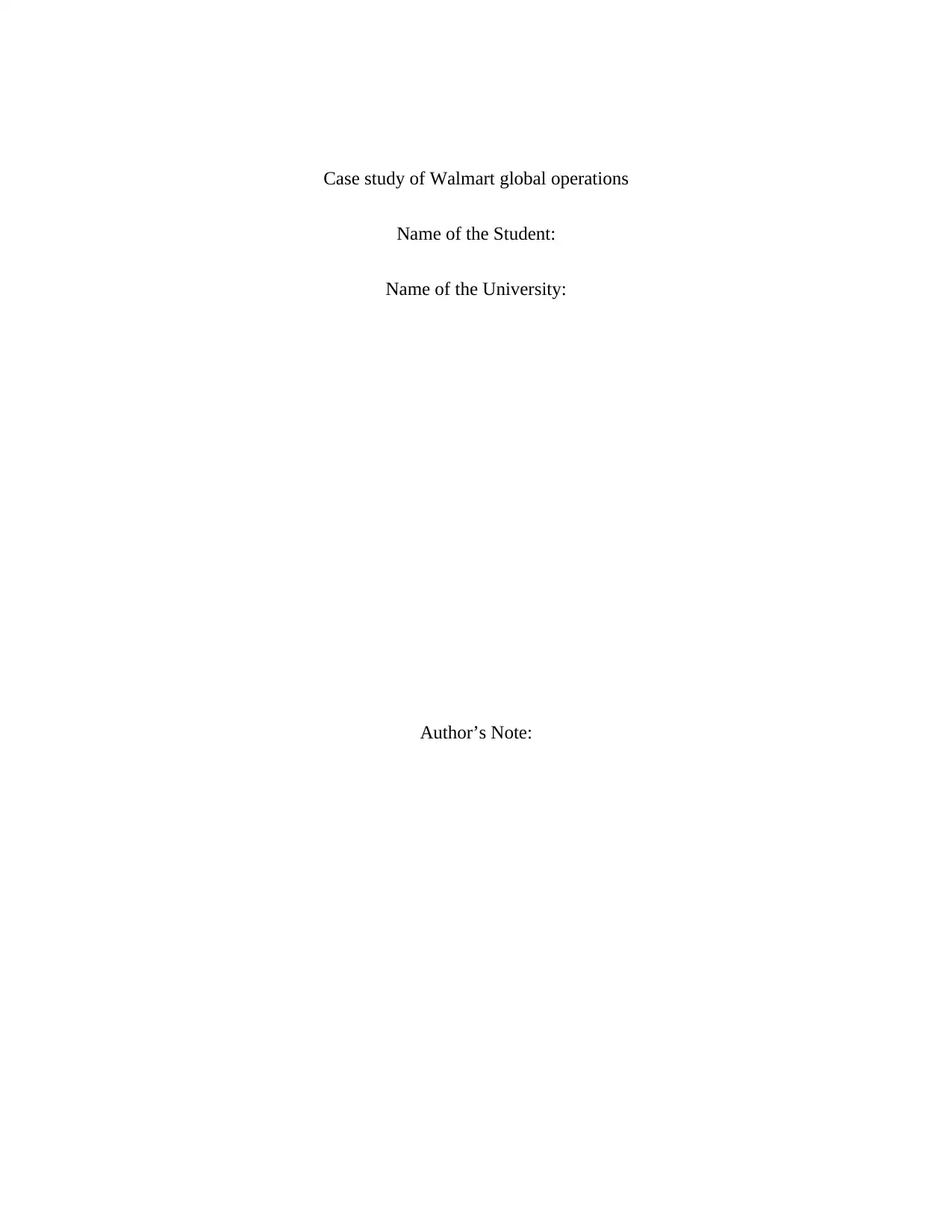
Case study of Walmart global operations
Name of the Student:
Name of the University:
Author’s Note:
Name of the Student:
Name of the University:
Author’s Note:
Paraphrase This Document
Need a fresh take? Get an instant paraphrase of this document with our AI Paraphraser
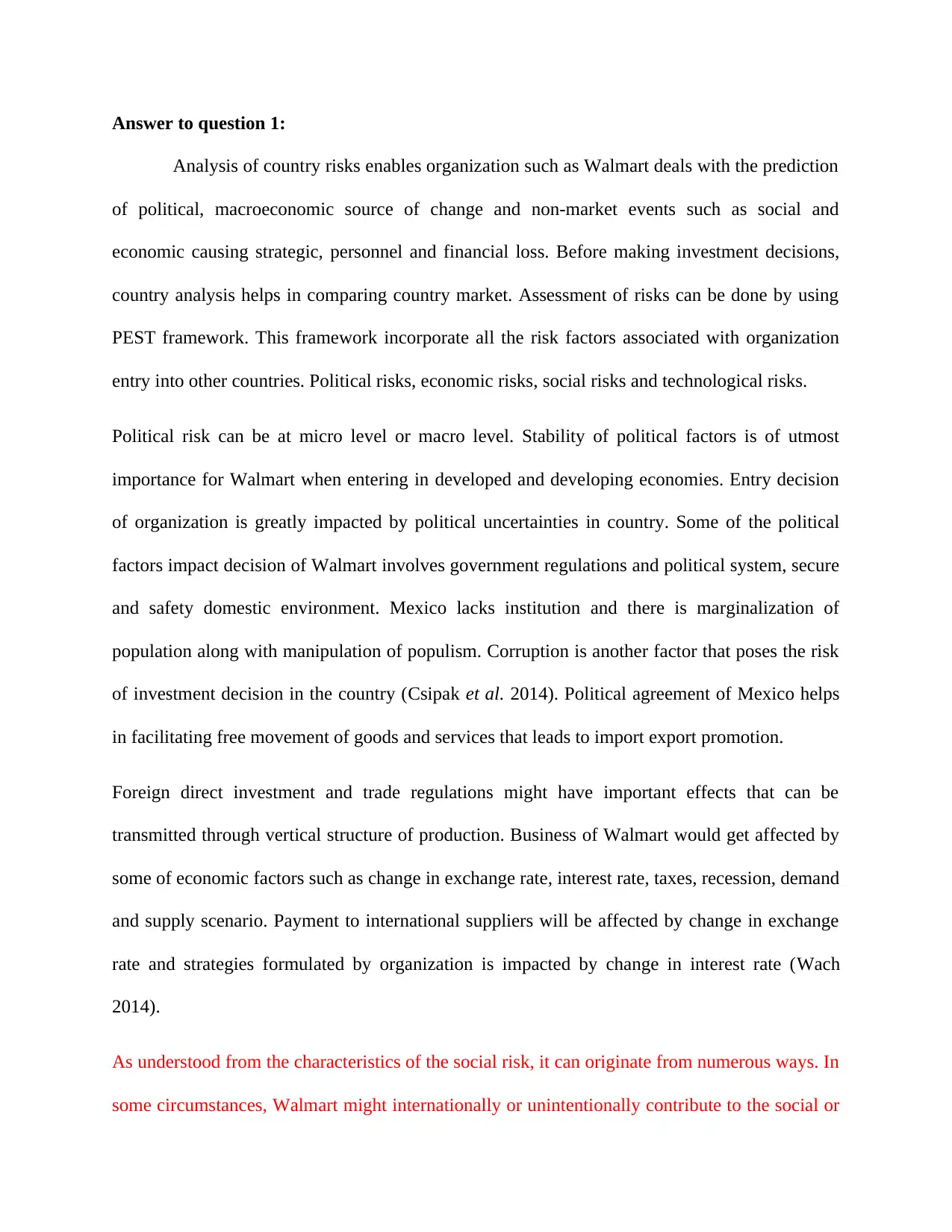
Answer to question 1:
Analysis of country risks enables organization such as Walmart deals with the prediction
of political, macroeconomic source of change and non-market events such as social and
economic causing strategic, personnel and financial loss. Before making investment decisions,
country analysis helps in comparing country market. Assessment of risks can be done by using
PEST framework. This framework incorporate all the risk factors associated with organization
entry into other countries. Political risks, economic risks, social risks and technological risks.
Political risk can be at micro level or macro level. Stability of political factors is of utmost
importance for Walmart when entering in developed and developing economies. Entry decision
of organization is greatly impacted by political uncertainties in country. Some of the political
factors impact decision of Walmart involves government regulations and political system, secure
and safety domestic environment. Mexico lacks institution and there is marginalization of
population along with manipulation of populism. Corruption is another factor that poses the risk
of investment decision in the country (Csipak et al. 2014). Political agreement of Mexico helps
in facilitating free movement of goods and services that leads to import export promotion.
Foreign direct investment and trade regulations might have important effects that can be
transmitted through vertical structure of production. Business of Walmart would get affected by
some of economic factors such as change in exchange rate, interest rate, taxes, recession, demand
and supply scenario. Payment to international suppliers will be affected by change in exchange
rate and strategies formulated by organization is impacted by change in interest rate (Wach
2014).
As understood from the characteristics of the social risk, it can originate from numerous ways. In
some circumstances, Walmart might internationally or unintentionally contribute to the social or
Analysis of country risks enables organization such as Walmart deals with the prediction
of political, macroeconomic source of change and non-market events such as social and
economic causing strategic, personnel and financial loss. Before making investment decisions,
country analysis helps in comparing country market. Assessment of risks can be done by using
PEST framework. This framework incorporate all the risk factors associated with organization
entry into other countries. Political risks, economic risks, social risks and technological risks.
Political risk can be at micro level or macro level. Stability of political factors is of utmost
importance for Walmart when entering in developed and developing economies. Entry decision
of organization is greatly impacted by political uncertainties in country. Some of the political
factors impact decision of Walmart involves government regulations and political system, secure
and safety domestic environment. Mexico lacks institution and there is marginalization of
population along with manipulation of populism. Corruption is another factor that poses the risk
of investment decision in the country (Csipak et al. 2014). Political agreement of Mexico helps
in facilitating free movement of goods and services that leads to import export promotion.
Foreign direct investment and trade regulations might have important effects that can be
transmitted through vertical structure of production. Business of Walmart would get affected by
some of economic factors such as change in exchange rate, interest rate, taxes, recession, demand
and supply scenario. Payment to international suppliers will be affected by change in exchange
rate and strategies formulated by organization is impacted by change in interest rate (Wach
2014).
As understood from the characteristics of the social risk, it can originate from numerous ways. In
some circumstances, Walmart might internationally or unintentionally contribute to the social or
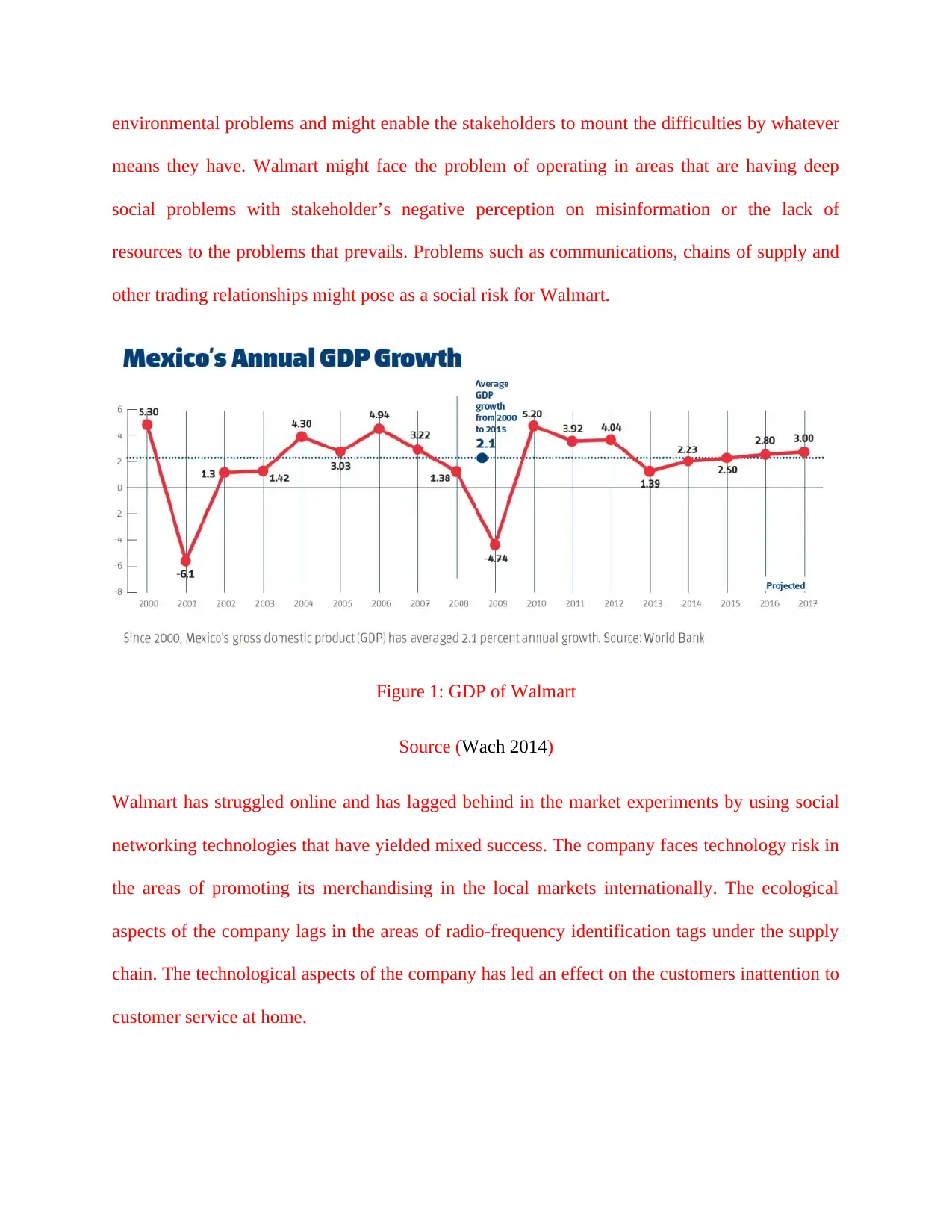
environmental problems and might enable the stakeholders to mount the difficulties by whatever
means they have. Walmart might face the problem of operating in areas that are having deep
social problems with stakeholder’s negative perception on misinformation or the lack of
resources to the problems that prevails. Problems such as communications, chains of supply and
other trading relationships might pose as a social risk for Walmart.
Figure 1: GDP of Walmart
Source (Wach 2014)
Walmart has struggled online and has lagged behind in the market experiments by using social
networking technologies that have yielded mixed success. The company faces technology risk in
the areas of promoting its merchandising in the local markets internationally. The ecological
aspects of the company lags in the areas of radio-frequency identification tags under the supply
chain. The technological aspects of the company has led an effect on the customers inattention to
customer service at home.
means they have. Walmart might face the problem of operating in areas that are having deep
social problems with stakeholder’s negative perception on misinformation or the lack of
resources to the problems that prevails. Problems such as communications, chains of supply and
other trading relationships might pose as a social risk for Walmart.
Figure 1: GDP of Walmart
Source (Wach 2014)
Walmart has struggled online and has lagged behind in the market experiments by using social
networking technologies that have yielded mixed success. The company faces technology risk in
the areas of promoting its merchandising in the local markets internationally. The ecological
aspects of the company lags in the areas of radio-frequency identification tags under the supply
chain. The technological aspects of the company has led an effect on the customers inattention to
customer service at home.
⊘ This is a preview!⊘
Do you want full access?
Subscribe today to unlock all pages.

Trusted by 1+ million students worldwide
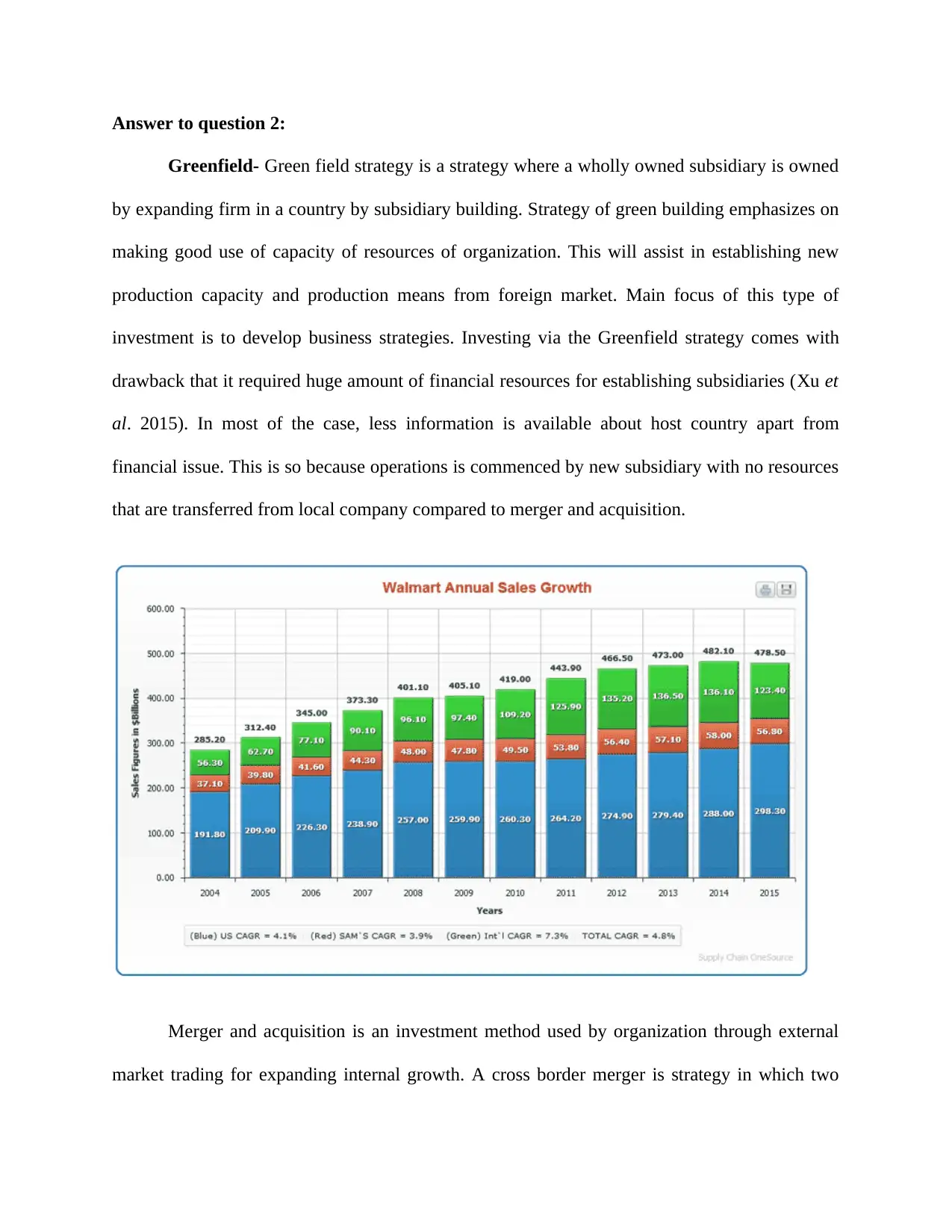
Answer to question 2:
Greenfield- Green field strategy is a strategy where a wholly owned subsidiary is owned
by expanding firm in a country by subsidiary building. Strategy of green building emphasizes on
making good use of capacity of resources of organization. This will assist in establishing new
production capacity and production means from foreign market. Main focus of this type of
investment is to develop business strategies. Investing via the Greenfield strategy comes with
drawback that it required huge amount of financial resources for establishing subsidiaries (Xu et
al. 2015). In most of the case, less information is available about host country apart from
financial issue. This is so because operations is commenced by new subsidiary with no resources
that are transferred from local company compared to merger and acquisition.
Merger and acquisition is an investment method used by organization through external
market trading for expanding internal growth. A cross border merger is strategy in which two
Greenfield- Green field strategy is a strategy where a wholly owned subsidiary is owned
by expanding firm in a country by subsidiary building. Strategy of green building emphasizes on
making good use of capacity of resources of organization. This will assist in establishing new
production capacity and production means from foreign market. Main focus of this type of
investment is to develop business strategies. Investing via the Greenfield strategy comes with
drawback that it required huge amount of financial resources for establishing subsidiaries (Xu et
al. 2015). In most of the case, less information is available about host country apart from
financial issue. This is so because operations is commenced by new subsidiary with no resources
that are transferred from local company compared to merger and acquisition.
Merger and acquisition is an investment method used by organization through external
market trading for expanding internal growth. A cross border merger is strategy in which two
Paraphrase This Document
Need a fresh take? Get an instant paraphrase of this document with our AI Paraphraser
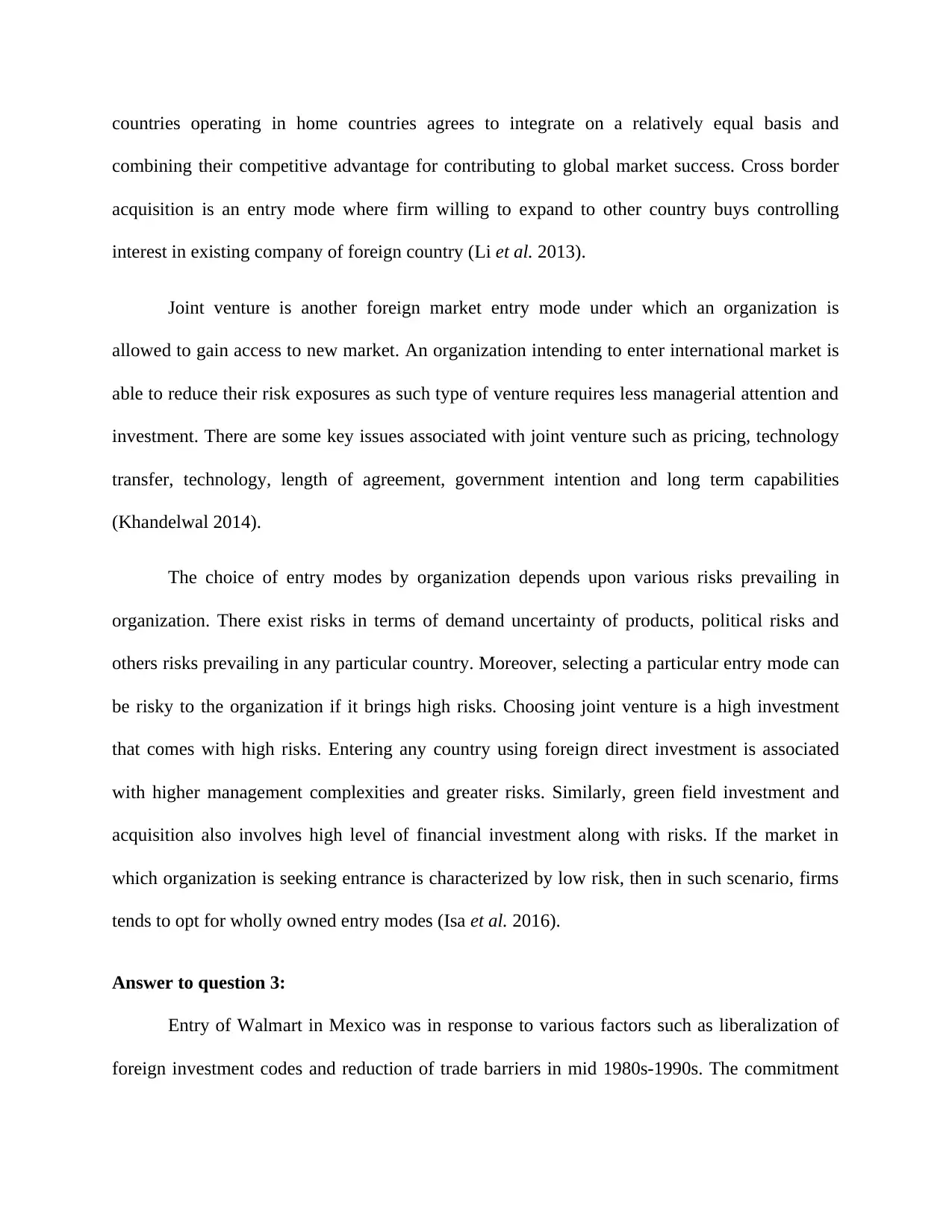
countries operating in home countries agrees to integrate on a relatively equal basis and
combining their competitive advantage for contributing to global market success. Cross border
acquisition is an entry mode where firm willing to expand to other country buys controlling
interest in existing company of foreign country (Li et al. 2013).
Joint venture is another foreign market entry mode under which an organization is
allowed to gain access to new market. An organization intending to enter international market is
able to reduce their risk exposures as such type of venture requires less managerial attention and
investment. There are some key issues associated with joint venture such as pricing, technology
transfer, technology, length of agreement, government intention and long term capabilities
(Khandelwal 2014).
The choice of entry modes by organization depends upon various risks prevailing in
organization. There exist risks in terms of demand uncertainty of products, political risks and
others risks prevailing in any particular country. Moreover, selecting a particular entry mode can
be risky to the organization if it brings high risks. Choosing joint venture is a high investment
that comes with high risks. Entering any country using foreign direct investment is associated
with higher management complexities and greater risks. Similarly, green field investment and
acquisition also involves high level of financial investment along with risks. If the market in
which organization is seeking entrance is characterized by low risk, then in such scenario, firms
tends to opt for wholly owned entry modes (Isa et al. 2016).
Answer to question 3:
Entry of Walmart in Mexico was in response to various factors such as liberalization of
foreign investment codes and reduction of trade barriers in mid 1980s-1990s. The commitment
combining their competitive advantage for contributing to global market success. Cross border
acquisition is an entry mode where firm willing to expand to other country buys controlling
interest in existing company of foreign country (Li et al. 2013).
Joint venture is another foreign market entry mode under which an organization is
allowed to gain access to new market. An organization intending to enter international market is
able to reduce their risk exposures as such type of venture requires less managerial attention and
investment. There are some key issues associated with joint venture such as pricing, technology
transfer, technology, length of agreement, government intention and long term capabilities
(Khandelwal 2014).
The choice of entry modes by organization depends upon various risks prevailing in
organization. There exist risks in terms of demand uncertainty of products, political risks and
others risks prevailing in any particular country. Moreover, selecting a particular entry mode can
be risky to the organization if it brings high risks. Choosing joint venture is a high investment
that comes with high risks. Entering any country using foreign direct investment is associated
with higher management complexities and greater risks. Similarly, green field investment and
acquisition also involves high level of financial investment along with risks. If the market in
which organization is seeking entrance is characterized by low risk, then in such scenario, firms
tends to opt for wholly owned entry modes (Isa et al. 2016).
Answer to question 3:
Entry of Walmart in Mexico was in response to various factors such as liberalization of
foreign investment codes and reduction of trade barriers in mid 1980s-1990s. The commitment
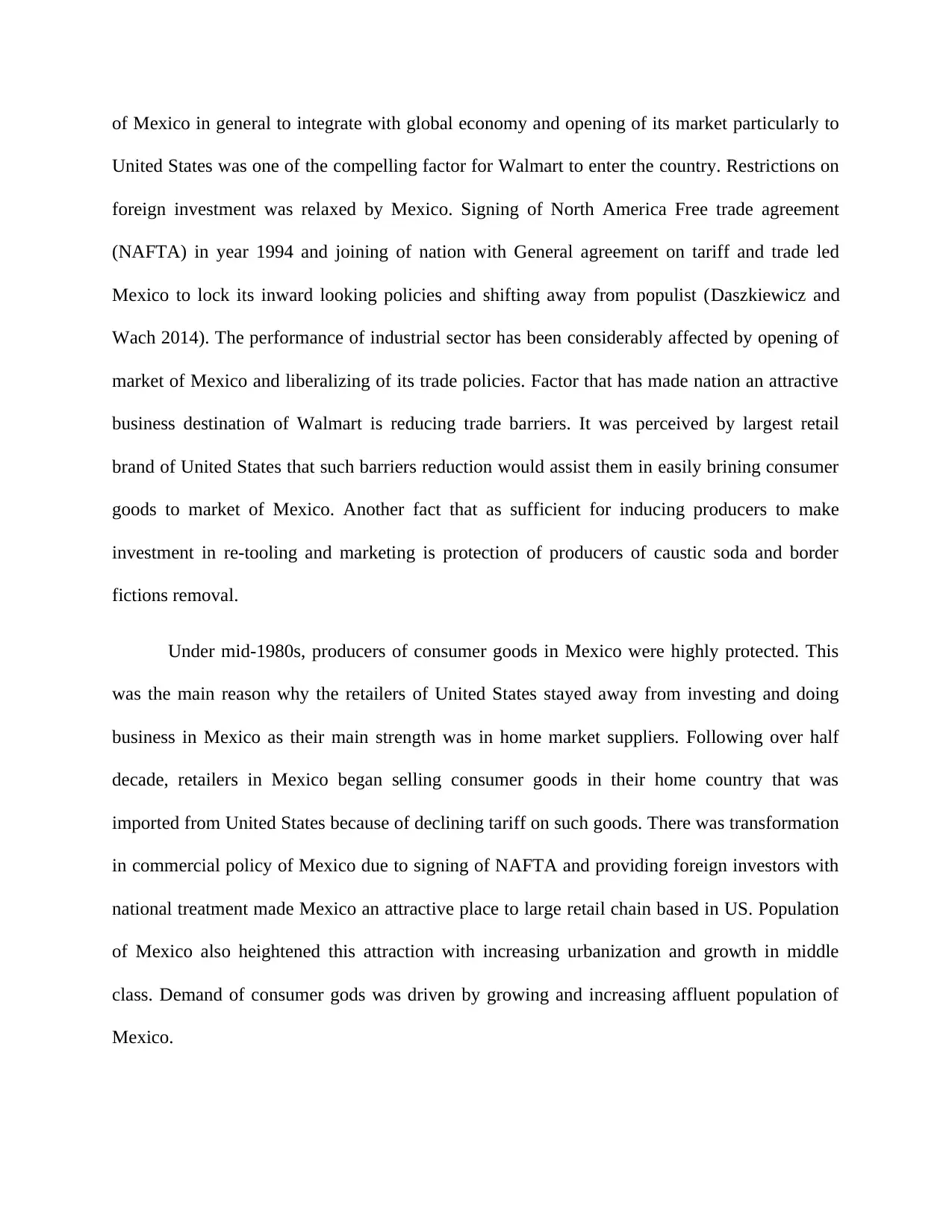
of Mexico in general to integrate with global economy and opening of its market particularly to
United States was one of the compelling factor for Walmart to enter the country. Restrictions on
foreign investment was relaxed by Mexico. Signing of North America Free trade agreement
(NAFTA) in year 1994 and joining of nation with General agreement on tariff and trade led
Mexico to lock its inward looking policies and shifting away from populist (Daszkiewicz and
Wach 2014). The performance of industrial sector has been considerably affected by opening of
market of Mexico and liberalizing of its trade policies. Factor that has made nation an attractive
business destination of Walmart is reducing trade barriers. It was perceived by largest retail
brand of United States that such barriers reduction would assist them in easily brining consumer
goods to market of Mexico. Another fact that as sufficient for inducing producers to make
investment in re-tooling and marketing is protection of producers of caustic soda and border
fictions removal.
Under mid-1980s, producers of consumer goods in Mexico were highly protected. This
was the main reason why the retailers of United States stayed away from investing and doing
business in Mexico as their main strength was in home market suppliers. Following over half
decade, retailers in Mexico began selling consumer goods in their home country that was
imported from United States because of declining tariff on such goods. There was transformation
in commercial policy of Mexico due to signing of NAFTA and providing foreign investors with
national treatment made Mexico an attractive place to large retail chain based in US. Population
of Mexico also heightened this attraction with increasing urbanization and growth in middle
class. Demand of consumer gods was driven by growing and increasing affluent population of
Mexico.
United States was one of the compelling factor for Walmart to enter the country. Restrictions on
foreign investment was relaxed by Mexico. Signing of North America Free trade agreement
(NAFTA) in year 1994 and joining of nation with General agreement on tariff and trade led
Mexico to lock its inward looking policies and shifting away from populist (Daszkiewicz and
Wach 2014). The performance of industrial sector has been considerably affected by opening of
market of Mexico and liberalizing of its trade policies. Factor that has made nation an attractive
business destination of Walmart is reducing trade barriers. It was perceived by largest retail
brand of United States that such barriers reduction would assist them in easily brining consumer
goods to market of Mexico. Another fact that as sufficient for inducing producers to make
investment in re-tooling and marketing is protection of producers of caustic soda and border
fictions removal.
Under mid-1980s, producers of consumer goods in Mexico were highly protected. This
was the main reason why the retailers of United States stayed away from investing and doing
business in Mexico as their main strength was in home market suppliers. Following over half
decade, retailers in Mexico began selling consumer goods in their home country that was
imported from United States because of declining tariff on such goods. There was transformation
in commercial policy of Mexico due to signing of NAFTA and providing foreign investors with
national treatment made Mexico an attractive place to large retail chain based in US. Population
of Mexico also heightened this attraction with increasing urbanization and growth in middle
class. Demand of consumer gods was driven by growing and increasing affluent population of
Mexico.
⊘ This is a preview!⊘
Do you want full access?
Subscribe today to unlock all pages.

Trusted by 1+ million students worldwide
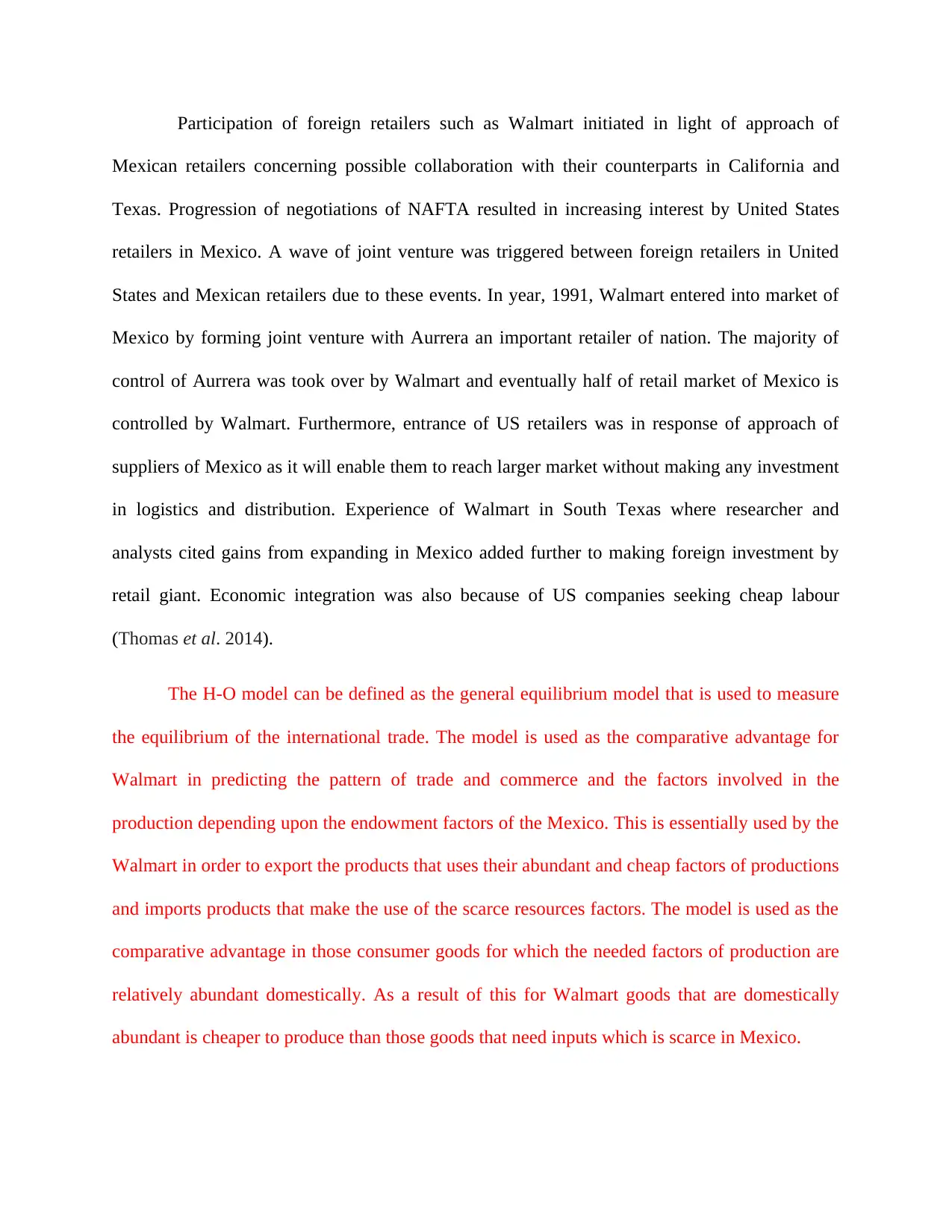
Participation of foreign retailers such as Walmart initiated in light of approach of
Mexican retailers concerning possible collaboration with their counterparts in California and
Texas. Progression of negotiations of NAFTA resulted in increasing interest by United States
retailers in Mexico. A wave of joint venture was triggered between foreign retailers in United
States and Mexican retailers due to these events. In year, 1991, Walmart entered into market of
Mexico by forming joint venture with Aurrera an important retailer of nation. The majority of
control of Aurrera was took over by Walmart and eventually half of retail market of Mexico is
controlled by Walmart. Furthermore, entrance of US retailers was in response of approach of
suppliers of Mexico as it will enable them to reach larger market without making any investment
in logistics and distribution. Experience of Walmart in South Texas where researcher and
analysts cited gains from expanding in Mexico added further to making foreign investment by
retail giant. Economic integration was also because of US companies seeking cheap labour
(Thomas et al. 2014).
The H-O model can be defined as the general equilibrium model that is used to measure
the equilibrium of the international trade. The model is used as the comparative advantage for
Walmart in predicting the pattern of trade and commerce and the factors involved in the
production depending upon the endowment factors of the Mexico. This is essentially used by the
Walmart in order to export the products that uses their abundant and cheap factors of productions
and imports products that make the use of the scarce resources factors. The model is used as the
comparative advantage in those consumer goods for which the needed factors of production are
relatively abundant domestically. As a result of this for Walmart goods that are domestically
abundant is cheaper to produce than those goods that need inputs which is scarce in Mexico.
Mexican retailers concerning possible collaboration with their counterparts in California and
Texas. Progression of negotiations of NAFTA resulted in increasing interest by United States
retailers in Mexico. A wave of joint venture was triggered between foreign retailers in United
States and Mexican retailers due to these events. In year, 1991, Walmart entered into market of
Mexico by forming joint venture with Aurrera an important retailer of nation. The majority of
control of Aurrera was took over by Walmart and eventually half of retail market of Mexico is
controlled by Walmart. Furthermore, entrance of US retailers was in response of approach of
suppliers of Mexico as it will enable them to reach larger market without making any investment
in logistics and distribution. Experience of Walmart in South Texas where researcher and
analysts cited gains from expanding in Mexico added further to making foreign investment by
retail giant. Economic integration was also because of US companies seeking cheap labour
(Thomas et al. 2014).
The H-O model can be defined as the general equilibrium model that is used to measure
the equilibrium of the international trade. The model is used as the comparative advantage for
Walmart in predicting the pattern of trade and commerce and the factors involved in the
production depending upon the endowment factors of the Mexico. This is essentially used by the
Walmart in order to export the products that uses their abundant and cheap factors of productions
and imports products that make the use of the scarce resources factors. The model is used as the
comparative advantage in those consumer goods for which the needed factors of production are
relatively abundant domestically. As a result of this for Walmart goods that are domestically
abundant is cheaper to produce than those goods that need inputs which is scarce in Mexico.
Paraphrase This Document
Need a fresh take? Get an instant paraphrase of this document with our AI Paraphraser
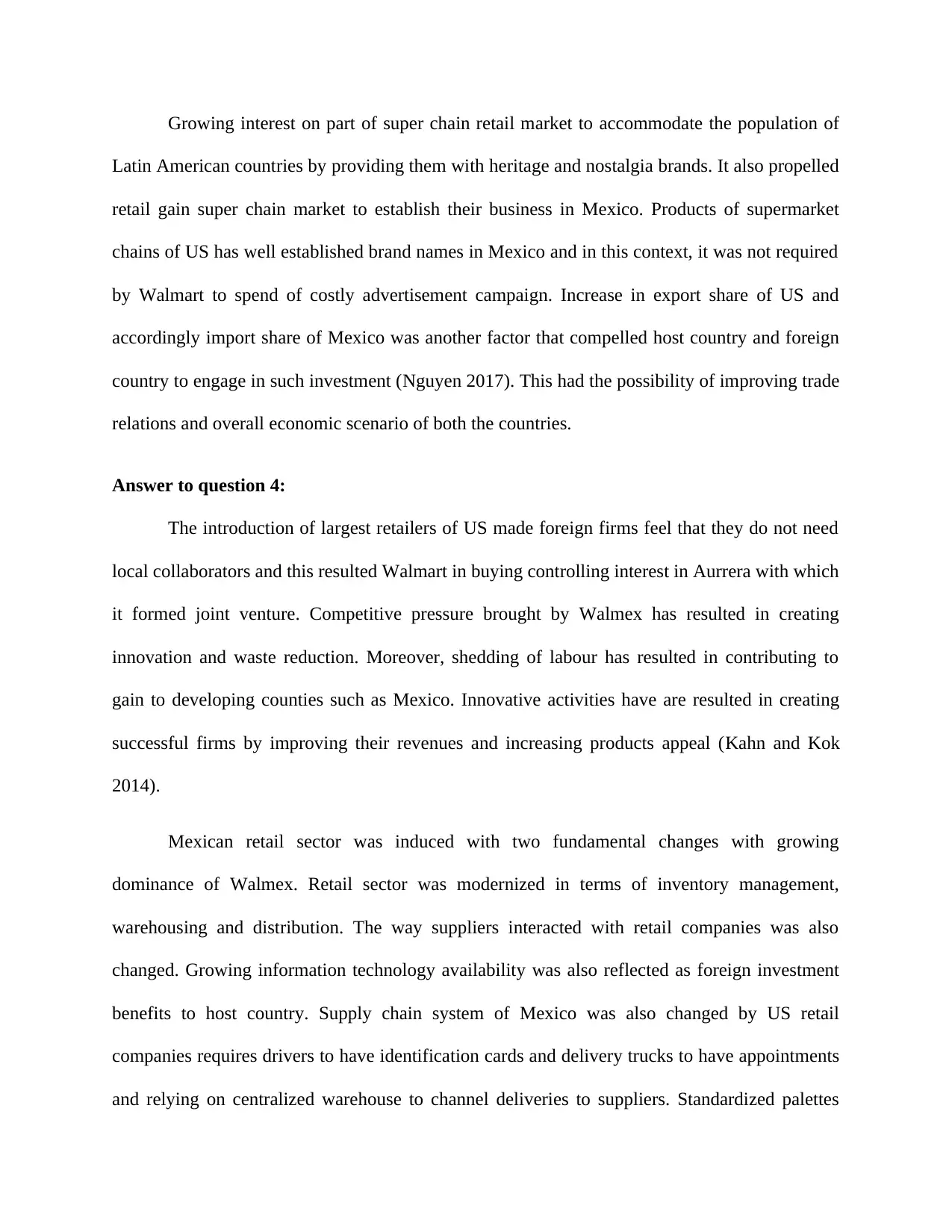
Growing interest on part of super chain retail market to accommodate the population of
Latin American countries by providing them with heritage and nostalgia brands. It also propelled
retail gain super chain market to establish their business in Mexico. Products of supermarket
chains of US has well established brand names in Mexico and in this context, it was not required
by Walmart to spend of costly advertisement campaign. Increase in export share of US and
accordingly import share of Mexico was another factor that compelled host country and foreign
country to engage in such investment (Nguyen 2017). This had the possibility of improving trade
relations and overall economic scenario of both the countries.
Answer to question 4:
The introduction of largest retailers of US made foreign firms feel that they do not need
local collaborators and this resulted Walmart in buying controlling interest in Aurrera with which
it formed joint venture. Competitive pressure brought by Walmex has resulted in creating
innovation and waste reduction. Moreover, shedding of labour has resulted in contributing to
gain to developing counties such as Mexico. Innovative activities have are resulted in creating
successful firms by improving their revenues and increasing products appeal (Kahn and Kok
2014).
Mexican retail sector was induced with two fundamental changes with growing
dominance of Walmex. Retail sector was modernized in terms of inventory management,
warehousing and distribution. The way suppliers interacted with retail companies was also
changed. Growing information technology availability was also reflected as foreign investment
benefits to host country. Supply chain system of Mexico was also changed by US retail
companies requires drivers to have identification cards and delivery trucks to have appointments
and relying on centralized warehouse to channel deliveries to suppliers. Standardized palettes
Latin American countries by providing them with heritage and nostalgia brands. It also propelled
retail gain super chain market to establish their business in Mexico. Products of supermarket
chains of US has well established brand names in Mexico and in this context, it was not required
by Walmart to spend of costly advertisement campaign. Increase in export share of US and
accordingly import share of Mexico was another factor that compelled host country and foreign
country to engage in such investment (Nguyen 2017). This had the possibility of improving trade
relations and overall economic scenario of both the countries.
Answer to question 4:
The introduction of largest retailers of US made foreign firms feel that they do not need
local collaborators and this resulted Walmart in buying controlling interest in Aurrera with which
it formed joint venture. Competitive pressure brought by Walmex has resulted in creating
innovation and waste reduction. Moreover, shedding of labour has resulted in contributing to
gain to developing counties such as Mexico. Innovative activities have are resulted in creating
successful firms by improving their revenues and increasing products appeal (Kahn and Kok
2014).
Mexican retail sector was induced with two fundamental changes with growing
dominance of Walmex. Retail sector was modernized in terms of inventory management,
warehousing and distribution. The way suppliers interacted with retail companies was also
changed. Growing information technology availability was also reflected as foreign investment
benefits to host country. Supply chain system of Mexico was also changed by US retail
companies requires drivers to have identification cards and delivery trucks to have appointments
and relying on centralized warehouse to channel deliveries to suppliers. Standardized palettes
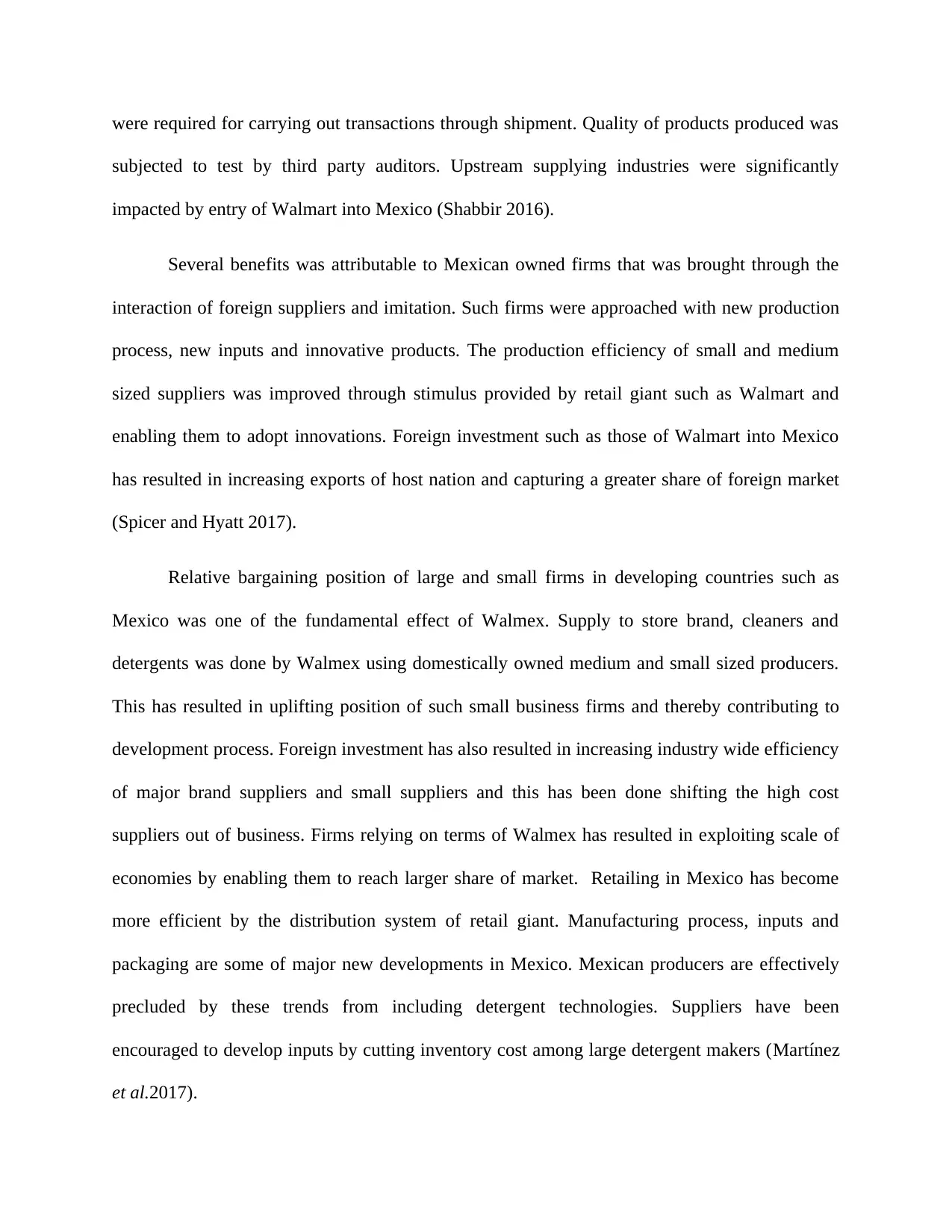
were required for carrying out transactions through shipment. Quality of products produced was
subjected to test by third party auditors. Upstream supplying industries were significantly
impacted by entry of Walmart into Mexico (Shabbir 2016).
Several benefits was attributable to Mexican owned firms that was brought through the
interaction of foreign suppliers and imitation. Such firms were approached with new production
process, new inputs and innovative products. The production efficiency of small and medium
sized suppliers was improved through stimulus provided by retail giant such as Walmart and
enabling them to adopt innovations. Foreign investment such as those of Walmart into Mexico
has resulted in increasing exports of host nation and capturing a greater share of foreign market
(Spicer and Hyatt 2017).
Relative bargaining position of large and small firms in developing countries such as
Mexico was one of the fundamental effect of Walmex. Supply to store brand, cleaners and
detergents was done by Walmex using domestically owned medium and small sized producers.
This has resulted in uplifting position of such small business firms and thereby contributing to
development process. Foreign investment has also resulted in increasing industry wide efficiency
of major brand suppliers and small suppliers and this has been done shifting the high cost
suppliers out of business. Firms relying on terms of Walmex has resulted in exploiting scale of
economies by enabling them to reach larger share of market. Retailing in Mexico has become
more efficient by the distribution system of retail giant. Manufacturing process, inputs and
packaging are some of major new developments in Mexico. Mexican producers are effectively
precluded by these trends from including detergent technologies. Suppliers have been
encouraged to develop inputs by cutting inventory cost among large detergent makers (Martínez
et al.2017).
subjected to test by third party auditors. Upstream supplying industries were significantly
impacted by entry of Walmart into Mexico (Shabbir 2016).
Several benefits was attributable to Mexican owned firms that was brought through the
interaction of foreign suppliers and imitation. Such firms were approached with new production
process, new inputs and innovative products. The production efficiency of small and medium
sized suppliers was improved through stimulus provided by retail giant such as Walmart and
enabling them to adopt innovations. Foreign investment such as those of Walmart into Mexico
has resulted in increasing exports of host nation and capturing a greater share of foreign market
(Spicer and Hyatt 2017).
Relative bargaining position of large and small firms in developing countries such as
Mexico was one of the fundamental effect of Walmex. Supply to store brand, cleaners and
detergents was done by Walmex using domestically owned medium and small sized producers.
This has resulted in uplifting position of such small business firms and thereby contributing to
development process. Foreign investment has also resulted in increasing industry wide efficiency
of major brand suppliers and small suppliers and this has been done shifting the high cost
suppliers out of business. Firms relying on terms of Walmex has resulted in exploiting scale of
economies by enabling them to reach larger share of market. Retailing in Mexico has become
more efficient by the distribution system of retail giant. Manufacturing process, inputs and
packaging are some of major new developments in Mexico. Mexican producers are effectively
precluded by these trends from including detergent technologies. Suppliers have been
encouraged to develop inputs by cutting inventory cost among large detergent makers (Martínez
et al.2017).
⊘ This is a preview!⊘
Do you want full access?
Subscribe today to unlock all pages.

Trusted by 1+ million students worldwide
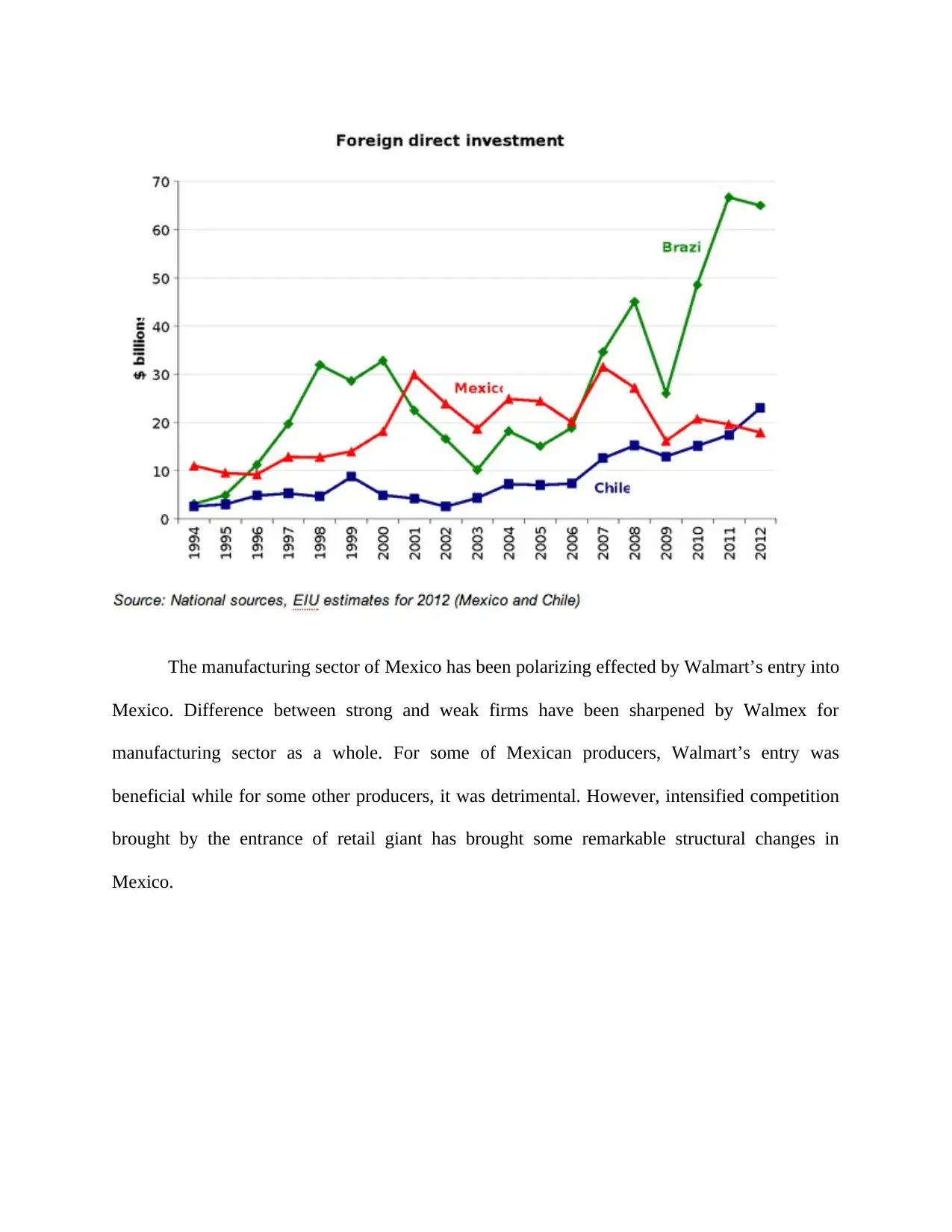
The manufacturing sector of Mexico has been polarizing effected by Walmart’s entry into
Mexico. Difference between strong and weak firms have been sharpened by Walmex for
manufacturing sector as a whole. For some of Mexican producers, Walmart’s entry was
beneficial while for some other producers, it was detrimental. However, intensified competition
brought by the entrance of retail giant has brought some remarkable structural changes in
Mexico.
Mexico. Difference between strong and weak firms have been sharpened by Walmex for
manufacturing sector as a whole. For some of Mexican producers, Walmart’s entry was
beneficial while for some other producers, it was detrimental. However, intensified competition
brought by the entrance of retail giant has brought some remarkable structural changes in
Mexico.
Paraphrase This Document
Need a fresh take? Get an instant paraphrase of this document with our AI Paraphraser

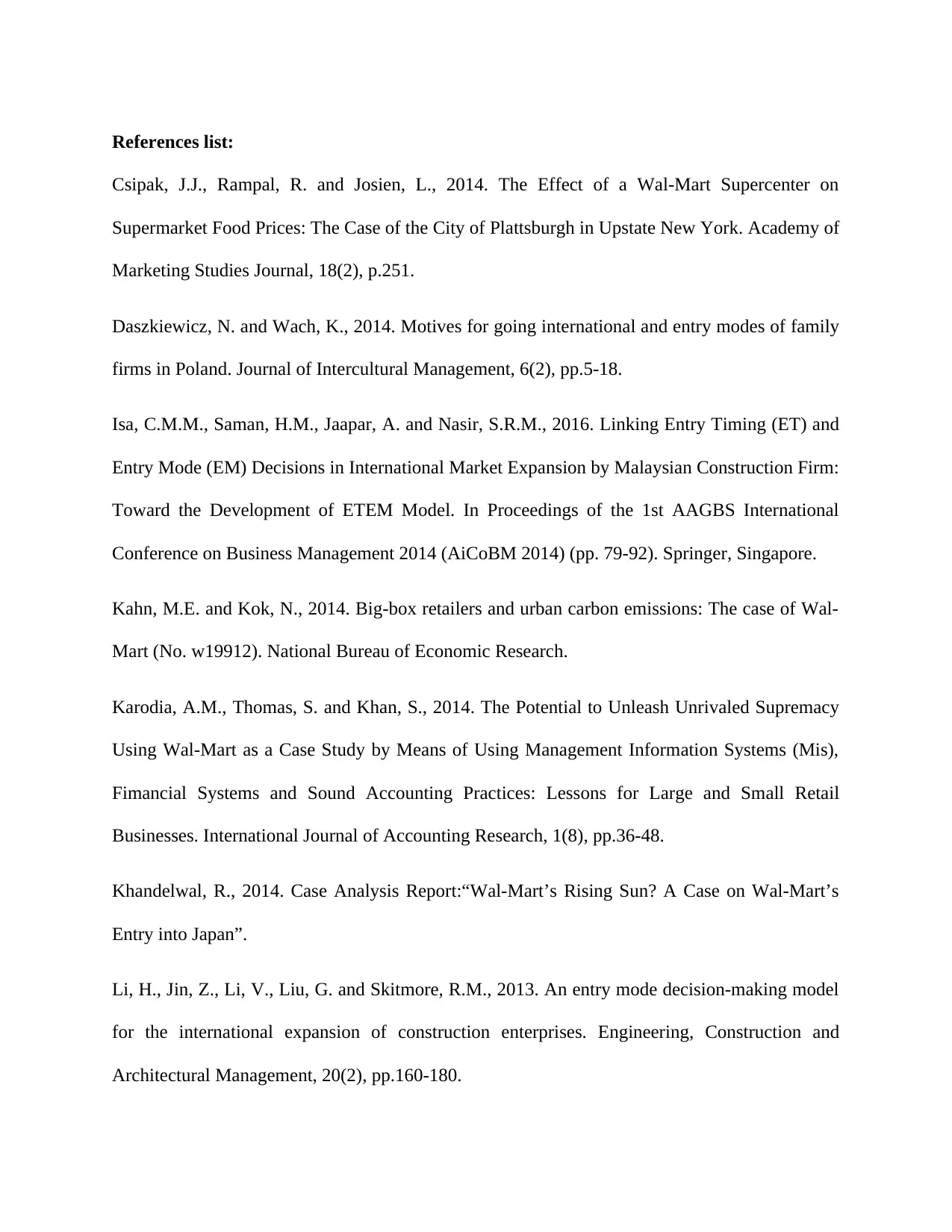
References list:
Csipak, J.J., Rampal, R. and Josien, L., 2014. The Effect of a Wal-Mart Supercenter on
Supermarket Food Prices: The Case of the City of Plattsburgh in Upstate New York. Academy of
Marketing Studies Journal, 18(2), p.251.
Daszkiewicz, N. and Wach, K., 2014. Motives for going international and entry modes of family
firms in Poland. Journal of Intercultural Management, 6(2), pp.5-18.
Isa, C.M.M., Saman, H.M., Jaapar, A. and Nasir, S.R.M., 2016. Linking Entry Timing (ET) and
Entry Mode (EM) Decisions in International Market Expansion by Malaysian Construction Firm:
Toward the Development of ETEM Model. In Proceedings of the 1st AAGBS International
Conference on Business Management 2014 (AiCoBM 2014) (pp. 79-92). Springer, Singapore.
Kahn, M.E. and Kok, N., 2014. Big-box retailers and urban carbon emissions: The case of Wal-
Mart (No. w19912). National Bureau of Economic Research.
Karodia, A.M., Thomas, S. and Khan, S., 2014. The Potential to Unleash Unrivaled Supremacy
Using Wal-Mart as a Case Study by Means of Using Management Information Systems (Mis),
Fimancial Systems and Sound Accounting Practices: Lessons for Large and Small Retail
Businesses. International Journal of Accounting Research, 1(8), pp.36-48.
Khandelwal, R., 2014. Case Analysis Report:“Wal-Mart’s Rising Sun? A Case on Wal-Mart’s
Entry into Japan”.
Li, H., Jin, Z., Li, V., Liu, G. and Skitmore, R.M., 2013. An entry mode decision-making model
for the international expansion of construction enterprises. Engineering, Construction and
Architectural Management, 20(2), pp.160-180.
Csipak, J.J., Rampal, R. and Josien, L., 2014. The Effect of a Wal-Mart Supercenter on
Supermarket Food Prices: The Case of the City of Plattsburgh in Upstate New York. Academy of
Marketing Studies Journal, 18(2), p.251.
Daszkiewicz, N. and Wach, K., 2014. Motives for going international and entry modes of family
firms in Poland. Journal of Intercultural Management, 6(2), pp.5-18.
Isa, C.M.M., Saman, H.M., Jaapar, A. and Nasir, S.R.M., 2016. Linking Entry Timing (ET) and
Entry Mode (EM) Decisions in International Market Expansion by Malaysian Construction Firm:
Toward the Development of ETEM Model. In Proceedings of the 1st AAGBS International
Conference on Business Management 2014 (AiCoBM 2014) (pp. 79-92). Springer, Singapore.
Kahn, M.E. and Kok, N., 2014. Big-box retailers and urban carbon emissions: The case of Wal-
Mart (No. w19912). National Bureau of Economic Research.
Karodia, A.M., Thomas, S. and Khan, S., 2014. The Potential to Unleash Unrivaled Supremacy
Using Wal-Mart as a Case Study by Means of Using Management Information Systems (Mis),
Fimancial Systems and Sound Accounting Practices: Lessons for Large and Small Retail
Businesses. International Journal of Accounting Research, 1(8), pp.36-48.
Khandelwal, R., 2014. Case Analysis Report:“Wal-Mart’s Rising Sun? A Case on Wal-Mart’s
Entry into Japan”.
Li, H., Jin, Z., Li, V., Liu, G. and Skitmore, R.M., 2013. An entry mode decision-making model
for the international expansion of construction enterprises. Engineering, Construction and
Architectural Management, 20(2), pp.160-180.
⊘ This is a preview!⊘
Do you want full access?
Subscribe today to unlock all pages.

Trusted by 1+ million students worldwide
1 out of 14
Related Documents
Your All-in-One AI-Powered Toolkit for Academic Success.
+13062052269
info@desklib.com
Available 24*7 on WhatsApp / Email
![[object Object]](/_next/static/media/star-bottom.7253800d.svg)
Unlock your academic potential
Copyright © 2020–2025 A2Z Services. All Rights Reserved. Developed and managed by ZUCOL.





